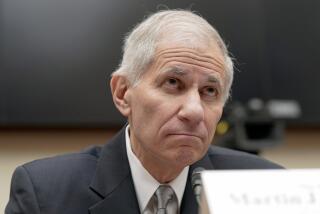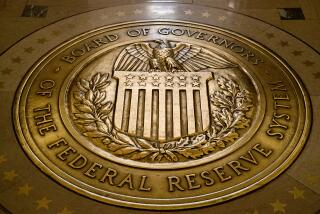Blinder’s Resignation a Sign Greenspan Will Stay
- Share via
WASHINGTON — Tight monetary policies--and Alan Greenspan, their architect at the Federal Reserve--are apparently sticking around for another four years.
That, according to Fed watchers, was the signal sent Wednesday by Alan Blinder’s decision to leave his post as vice chairman of the Federal Reserve System’s Board of is Governors.
Blinder had been considered a possible successor to Greenspan as Fed chairman when Greenspan’s term expires March 2. But Blinder’s announcement that he will return to Princeton University, where his leave of absence is about to expire, rather than accept reappointment to the Fed when his own term expires Jan. 31.
“If Alan Blinder had thought there was a possibility of being chairman, he would not be doing this. You can take it as a signal the president intends to reappoint Alan Greenspan,” said C. Fred Bergsten, director of the Institute for International Economics and a basketball-playing companion of the 50-year-old Blinder.
Since arriving at the Fed in April 1994, Blinder has consistently been the voice favoring a more relaxed monetary policy than the course the Fed ultimately followed--although in the end he has joined the Fed’s consensus for relatively high interest rates.
Despite that, Blinder’s departure is unlikely to change the Fed’s direction, a senior official there said, pointing to the consensus under which the Fed operates. As chairman, Greenspan engineered a series of interest rate increases in 1994 designed to protect against the possibility of renewed inflation even before any signs of inflation were apparent. Then last year, as economic growth cooled, Greenspan was reluctant to let rates come back down.
Blinder, on the other hand, was “always arguing that the Fed was leaning a bit too much on the tightening side,” Bergsten said.
Greenspan’s precise operation of the interest rate levers has won praise on Wall Street, which issued its own vote of confidence in the economy with soaring stock prices in 1995.
Blinder’s departure, coupled with President Clinton’s apparent intention to give Greenspan four more years, signals that the White House has decided that leaving Greenspan at the helm is preferable to shaking up the markets by replacing him.
By denying Greenspan reappointment, the Clinton administration would risk sending the markets into a tailspin half a year before election day. Few think Clinton would take that risk, despite Greenspan’s adherence to a tight-money policy that some say could itself hold down economic growth as the election approaches.
Blinder will no longer be available to provide a counterpoint on the Fed to Greenspan’s stance. “Blinder is a voice for a somewhat more aggressive monetary policy, and Clinton is going to need some voice for that at the Fed if the economy slows down in the next nine months,” said Jeff Faux, president of the Economic Policy Institute, a think tank that generally favors liberal approaches to economic issues.
Even with economic growth predicted at 2% to 2.5% for 1996, Faux said, “one can look at that and say that’s not good enough for the reelection of a Democratic president. . . .”
Blinder said in a statement issued Wednesday that he told Clinton of his decision Tuesday.
The vice chairman, who had served as a member of Clinton’s Council of Economic Advisers before moving to the Fed, said he made the switch with the idea of serving until the expiration of his term and then returning to Princeton.
* EASING POSSIBLE
The Fed says the economy almost inflation-free. D2
More to Read
Get the L.A. Times Politics newsletter
Deeply reported insights into legislation, politics and policy from Sacramento, Washington and beyond. In your inbox twice per week.
You may occasionally receive promotional content from the Los Angeles Times.










